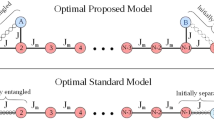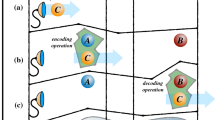Abstract
We review the dual-rail encoding (Burgarth and Bose, Phys Rev A 71:052315, 2005) which demonstrates how the problem of dispersion in quantum state transfer in spin chain communication can be attacked and overcome through performing measurements at the receiver side. We discuss the performance of the dual-rail technique in detail with respect to noise, disorder in the chain couplings (Burgarth and Bose, New J Phys 7:135, 2005) and deviations from a strict one-dimensionality. We then show how the dual-rail method can be made more efficient by using multiple channels (Burgarth et al., Int J Quant Inf 4:405, 2006; J Phys A Math Gen 38:6793, 2005). We provide a convergence theorem which shows that any nearest-neighbor excitation preserving chain is capable of efficient and perfect state transfer using a multi-rail encoding.
Access this chapter
Tax calculation will be finalised at checkout
Purchases are for personal use only
Similar content being viewed by others
Notes
- 1.
Specifically, we identify the vector \(\left \vert \boldsymbol{0}\right \rangle _{i}\) with the factorized state where all the qubits of the chain are initialized in |0⟩, while \(\left \vert \boldsymbol{n}\right \rangle _{i}\) with the factorized state where all the qubits of the chain are in zero apart from the n-th one which is in \(\vert 1\rangle\).
- 2.
This is not a strong assumption. If the excitation was fully randomly distributed, the probability would scale as N −1. By searching for good arrival times, this can be slightly increased to N −2∕3.
- 3.
Notice that strictly speaking the eigenvectors of the Hamiltonian are not the same as those of the time evolution operators. The latter still can have evolution times at which additional degeneracy can increase the set of eigenstates. A trivial example is given for t = 0 where all states become eigenstates. But it is always possible to find times t at which the eigenstates of U(t) coincide with those of H.
References
R. Raussendorf, H.J. Briegel, Phys. Rev. Lett. 86, 5188 (2001)
S. Bose, Phys. Rev. Lett. 91, 207901 (2003)
M. Christandl, N. Datta, T.C. Dorlas, A. Ekert, A. Kay, A.J. Landahl, Phys. Rev. A 71, 032312 (2005)
M.A. Nielsen, I.L. Chuang, Quantum Computation and Quantum Information (Cambridge University Press, Cambridge, 2000)
V. Giovannetti, R. Fazio, Phys. Rev. A 71, 032314 (2005)
D. Burgarth, S. Bose, Phys. Rev. A 71, 052315 (2005)
D. Burgarth, S. Bose, New. J. Phys. 7, 135 (2005)
D. Burgarth, S. Bose, V. Giovannetti, Int. J. Quant. Inf. 4, 405 (2006)
D. Burgarth, V. Giovannetti, S. Bose, J. Phys. A: Math. Gen. 38, 6793 (2005)
I.L. Chuang, Y. Yamamoto, Phys. Rev. Lett. 76, 4281 (1996)
N. Motoyama, H. Eisaki, S. Uchida, Phys. Rev. Lett. 76, 3212 (1996)
P. Gambardella, A. Dallmeyer, K. Maiti, M.C. Malagoli, W. Eberdardt, K. Kern, C. Carbone, Nature 416, 301 (2002)
T. Yamamoto, Y.A. Pashkin, O. Astafiev, Y. Nakamura, J.S. Tsai, Nature 425, 941 (2003)
A. Romito, R. Fazio, C. Bruder, Phys. Rev. B 71, 100501(R) (2005)
C.H. Bennett, D.P. DiVincenzo, J.A. Smolin, Phys. Rev. Lett. 78, 3217 (1997)
D. Vion, A. Aassime, A. Cottet, P. Joyez, H. Pothier, C. Urbina, D. Esteve, M.H. Devoret, Science 296, 886 (2002)
I. Chiorescu, Y. Nakamura, C.J.P.M. Harmans, J.E. Mooij, Science 299, 1869 (2003)
G.M. Palma, K.A. Suominen, A.K. Ekert, Proc. R. Soc. Lond. A 452, 567 (1996)
W.Y. Hwang, H. Lee, D.D. Ahn, S.W. Hwang, Phys. Rev. A 62, 062305 (2000)
A. Beige, D. Braun, P. Knight, New J. Phys. 2, 22 (2000)
M. Plenio, P. Knight, Rev. Mod. Phys. 70, 101 (1998)
H.P. Breuer, F. Petruccione, The Theory of Open Quantum Systems (Oxford University Press, Oxford, 2002)
G.D. Chiara, D. Rossini, S. Montangero, R. Fazio, Phys. Rev. A 72, 012323 (2005)
L. Dan, Z. Jing-Fu, Chin. Phys. 15, 272 (2006)
P.W. Anderson, Phys. Rev. 109, 1492 (1958)
J.P. Keating, N. Linden, J.C.F. Matthews, A. Winter Phys. Rev. A 75, 012315 (2007)
T.J.G. Apollaro, F. Plastina, Phys. Rev. A 74, 062316 (2006)
D. Burgarth, K. Maruyama, F. Nori, Phys. Rev. A 79, 020305R (2009)
B. Sutherland, Phys. Rev. B 12, 3795 (1975)
C. Hadley, A. Serafini, S. Bose, Phys. Rev. A 72, 052333 (2005)
A. Bayat, V. Karimipour, Phys. Rev. A 75, 022321 (2007)
C.H. Bennett, P.W. Shor, IEEE Trans. Inf. Theory 44, 2724 (1998)
J.R. Schott, Matrix Analysis for Statistics (Wiley-Interscience, Hoboken, 1996)
N. Gisin, N. Linden, S. Massar, S. Popescu, Phys. Rev. A 72, 012338 (2005)
A. Kay, M. Ericsson, New. J. Phys. 7, 143 (2005)
B. Vaucher, D. Burgarth, S. Bose, J. Opt. B: Quantum Semiclass. Opt. 7, S356 (2005)
B. Vaucher, Quantum communication of spin-qubits using a collaborative approach. Master’s thesis, Ecole Polytechnique Federale de Lausanne (2005)
M. Avellino, A.J. Fisher, S. Bose, Phys. Rev. A 74, 012321 (2006)
A. Kay, Phys. Rev. A 73, 032306 (2006)
Author information
Authors and Affiliations
Corresponding author
Editor information
Editors and Affiliations
Rights and permissions
Copyright information
© 2014 Springer-Verlag Berlin Heidelberg
About this chapter
Cite this chapter
Burgarth, D.K., Giovannetti, V. (2014). Dual- and Multi-rail Encoding. In: Nikolopoulos, G., Jex, I. (eds) Quantum State Transfer and Network Engineering. Quantum Science and Technology. Springer, Berlin, Heidelberg. https://doi.org/10.1007/978-3-642-39937-4_3
Download citation
DOI: https://doi.org/10.1007/978-3-642-39937-4_3
Published:
Publisher Name: Springer, Berlin, Heidelberg
Print ISBN: 978-3-642-39936-7
Online ISBN: 978-3-642-39937-4
eBook Packages: Physics and AstronomyPhysics and Astronomy (R0)




